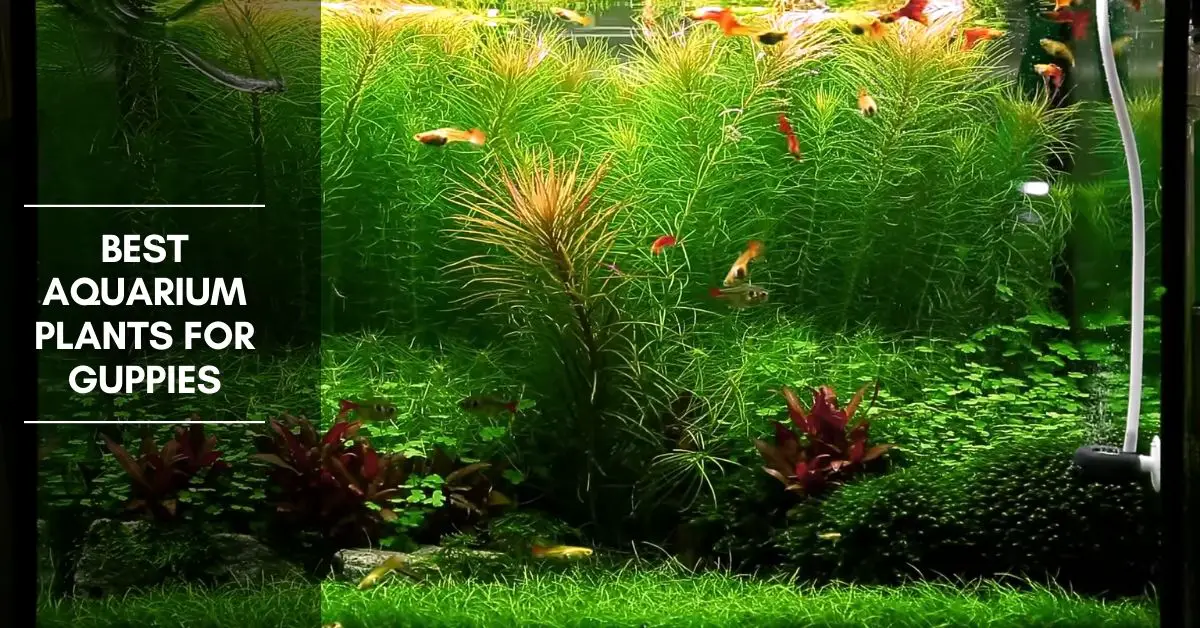Tall bushy varieties are best used as background plants in the rear corners of guppies’ tank and along the back. They can be arranged in front of heaters, filter tubes, air hoses, and box filters so that they hide these unsightly items.
Other varieties of shorter plants can be placed in front of the background plants to provide, as it were, a natural progression of height toward the back of the aquarium. This progression creates a well-balanced overall pleasing effect, and it leaves the guppies plenty of open swimming room at the front of the tank where they will be more visible most of the time.
If at times the guppies need more seclusion, they can swim through the plant thickets or hide behind them.
[amazon table=”6474″]
Plant Varieties for Guppies Aquarium
There are quite a few commonly available plants (and a few uncommon ones) that do well in a new, nutrient-poor guppies aquarium.
Java Fern

One of the easiest plants to grow in an aquarium is the Java Fern (Microsorum pteropus). This plant has a thick rhizome that produces light-green to dark-green leaves shaped like elongated spearheads.
The rhizome grows along the surface of whatever the plant becomes rooted to, which can be the gravel, a piece of driftwood, or even a rock and new leaves arise from the rhizome.
The leaves can be as long as 8 to 9 inches (20 to 23 cm), but in the cool water of a guppies aquarium, they usually grow to only about 4 inches (10 cm). This plant, therefore, makes a nice foreground decoration. It comes from India, southern China, and the Indo-Malayan area as far as the Philippine Islands, where it is an amphibious species, growing right up out of the water along the trunks of partially submerged fallen trees.
A unique feature of Java Fern is that it can thrive in dim light or bright light, and it can tolerate acidic or alkaline water, as long as extremes are avoided.
It does well in a normal range of aquarium temperatures, from a low of about 68°F (20°C) to a high of about 80°F (27’C).
The rhizome of Java Fern should be weighted down on the gravel surface with a small rock. Embedding it in the gravel seems to slow down its growth. It can also be tied to a piece of driftwood or rock, with a piece of monofilament fishing line.
Eventually, the roots will attach to these surfaces It reproduces by extending the rhizome horizontally, with the leaf stalks growing straight up out of it. If a piece of a broken leaf is anchored down, it will eventually produce a new rootstock or rhizome, and new leaves will sprout from it. This beautiful plant is worth seeking out for use in a newly established aquarium.
Water Sprite
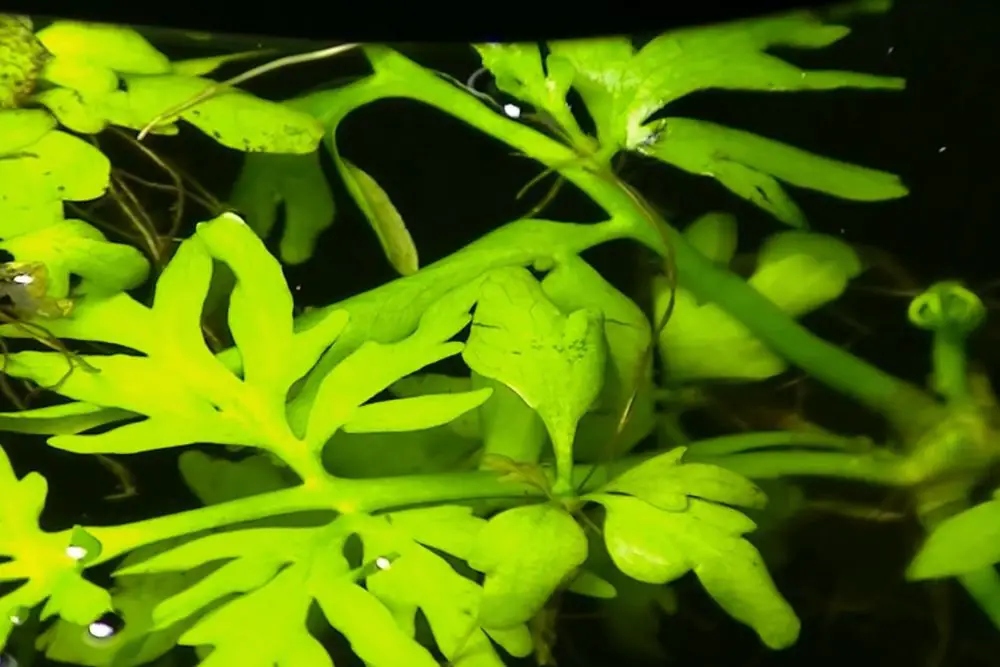
The water sprite (Ceratopteris thalictroides) is a commonly available aquatic fern that is also extremely versatile in its requirements. It grows best in acidic, shaded water, but it also grows quite well in normal aquarium water in a moderate, but not excessive, amount of light.
It has deeply forked bright green leaves Like Java Fern. it reproduces by developing buds right on the leaves. The leaves are quite fragile, but almost any small fragment is capable of producing new leaf buds. Because water sprite is so soft and fragile, guppies may eat large amounts of it.
This is not a problem, though, because the plant usually grows faster than most fish can consume it. Water sprite grows in a floating form, which reproduces so fast that it quickly covers the water surface with a dense layer of small plants. The weak, bushy roots can be embedded in the gravel. This plant can take several different forms, depending on current environmental conditions.
Tetra AquaSafe Plus, 8.45 Ounces, aquarium Water Conditioner And Dechlorinator, Model Number: 46798162681
$8.49 (as of July 13, 2024 11:01 GMT +03:00 - More infoProduct prices and availability are accurate as of the date/time indicated and are subject to change. Any price and availability information displayed on [relevant Amazon Site(s), as applicable] at the time of purchase will apply to the purchase of this product.)API TAP WATER CONDITIONER Aquarium Water Conditioner 16-Ounce Bottle
(as of July 13, 2024 06:40 GMT +03:00 - More infoProduct prices and availability are accurate as of the date/time indicated and are subject to change. Any price and availability information displayed on [relevant Amazon Site(s), as applicable] at the time of purchase will apply to the purchase of this product.)API STRESS COAT Aquarium Water Conditioner 4-Ounce Bottle (85B)
40% OffThe leaves can be deeply forked, resembling some of the fine-leaved plants like Cabomba Caroliniana. Temperature requirements range from a minimum of 68°F (20°C) to a high of about 80°F (27°C).
Cryptocoryne
Several species of Cryptocoryne, which are sometimes known simply as crypts, are commonly available. All Cryptocoryne come from tropical Asia. They are generally not tolerant of temperatures below 70°F (21°C), so most varieties can be suitable for a guppies tank.
Some crypts are amphibious, whereas others are completely aquatic. Marsh species, such as Cryptocoryne Beckettii and Cryptocoryne Willisii, are often grown in domestic aquatic nurseries.
They are small foreground plants with narrow spear-shaped leaves that rarely exceed 6 inches (15 cm) in length. Of these two, the easiest for beginners to handle is Cryptocoryne Beckettii.
It grows in almost any water and can tolerate strong or weak light. It can also tolerate a water temperature as low as 70°F (21°C) without much adverse effect on its growth. It reproduces easily by sending runners out of its thick rhizome, or rootstock. It is a good plant for a new aquarium.
Aponogeton
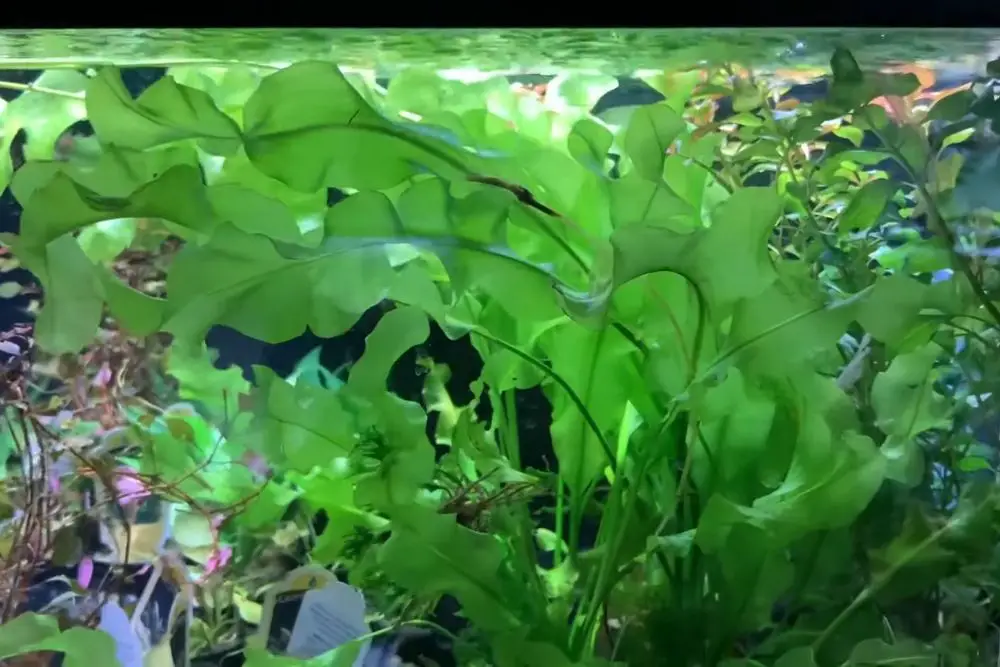
Aponogetons are good plants for a new guppy aquarium because they have a thick tuber that contains a vast food supply that can sustain the plants for months in a nutrient-poor aquarium.
However, once the food supply is used up and the tuber begins to rot, the plant is not very easy to bring back to good health. If good aquarium maintenance is practiced, there is usually sufficient nutrient material in the tank before any serious tuber rot occurs.
The common Aponogetons, such as Aponogeton Undulatus and Aponogeton Natans have leaves that are long and undulate (curled or crinkled) along their edges. The plant thrives well in almost any normal aquarium water and can tolerate temperatures as low as 60°F (16°C). At that cool a temperature, however, some species shed their leaves and the plant goes into a dormant state. New leaves begin to grow when the water temperature rises into the high 60s (approximately 20°C).
Sword plants
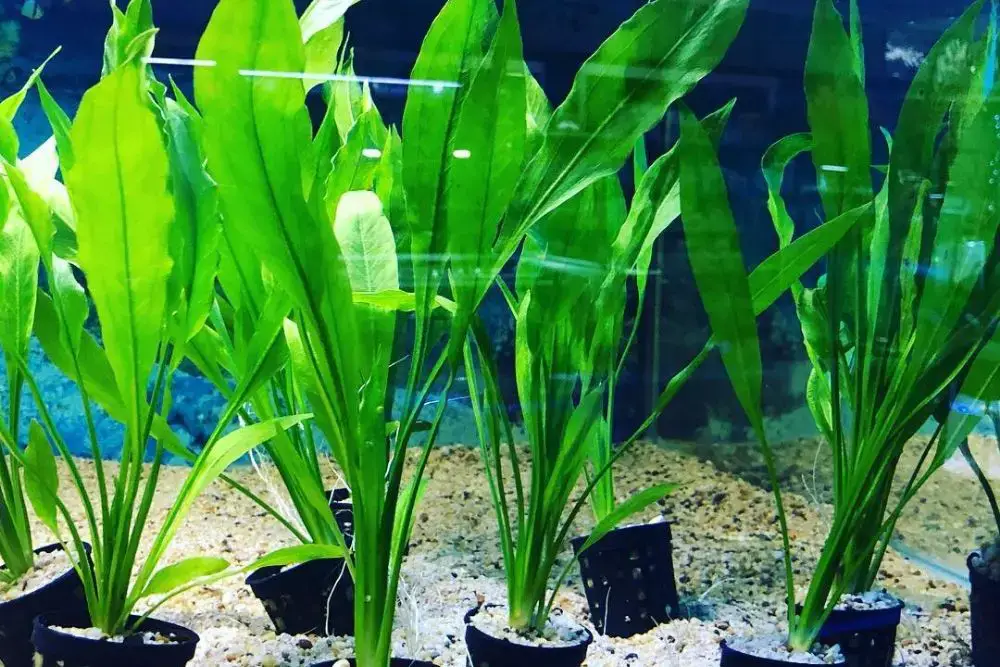
Sword plants (Echinodorus species) are found almost exclusively in South America, especially in Brazil. One of the easiest to grow in almost any aquarium, new or old. It has large, bright-green leaves that are elongate and spear-shaped, like those of the crypts, but they are proportionately much broader.
The leaf blades have strong veins and can grow to a length of 12 inches (30 cm). The plant grows well in a new aquarium because it has an unusually heavy rhizome for a sword plant. It is tolerant of temperatures as low as 65°F (18°C).
This plant requires very strong overhead light. A single Sword plant makes a spectacular central focal point in an aquarium. The Amazon sword plant (Echinodorus Grisebachii) looks very much like Echinodorus Osiris, except that it does not have much of a rootstock.
Although quite popular in fish stores, it should not be planted in a new aquarium. Another species, Echinodorus Cordifolius (formerly known as E. Radicans), is well suited for Corkscrew val. Val is a common name for Vallisneria – is probably the most popular in this group of rooted plants. Its narrow, ribbonlike leaves grow upward in spirals – hence the name corkscrew.
The plant grows wild in the southern part of the United States and is therefore well suited to the temperatures in a guppies aquarium. It grows quite well in normal aquarium water. However, because it has a very small rootstock, it should not be used until the aquarium has aged for a few months.
Various Sagittaria species, known by the common name sag, grow in most of the tropical and temperate zones of the world. Two have become quite popular in the aquarium trade, the most common being the dwarf sag (Sagittaria Subulata).
The narrow bladelike leaves grow to a length of 2 to 3 inches (5 to 7.5 cm). In strong light the plant quickly spreads by means of runners, forming a nice green carpet, so to speak, in the foreground of the aquarium.
The plant is extremely versatile in its water requirements and grows well in a nutrient-poor aquarium, because it has more of a rootstock than most other Vallisneria or Elgittario species. Sagittaria Graminea is the Other sag species commonly used in the aquarium. Its leaves are proportionately broader than those of the dwarf sag and reach a length of about 10 to 12 inches (25 to 31 cm). It too, grows welt in a medium that is not very rich in nutrients and in water of almost any composition.
Aquarium Banana Plant
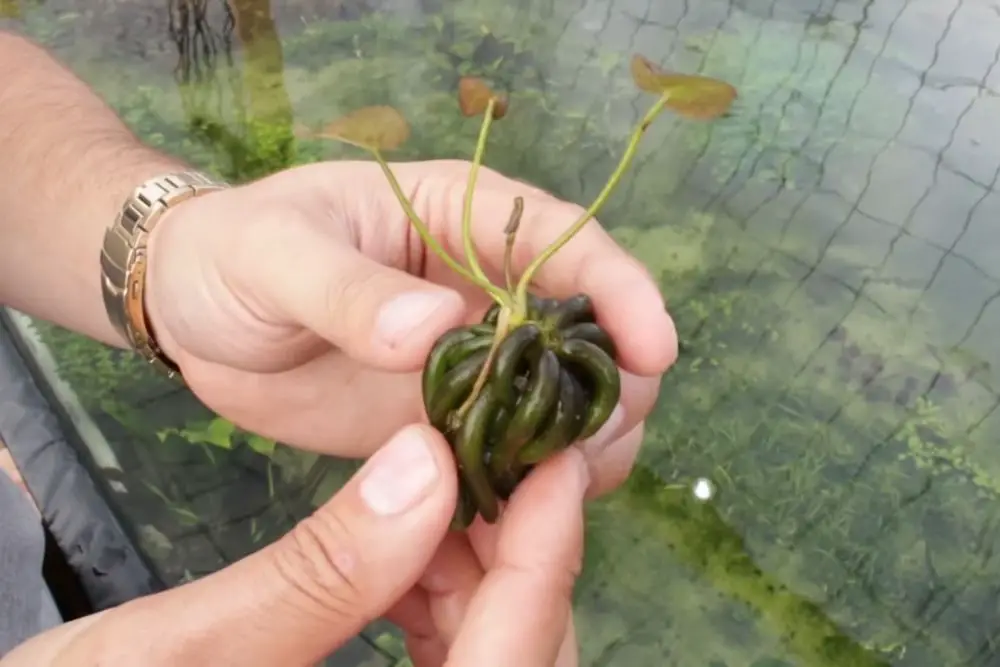
The underwater banana plant is quite popular in the aquarium hobby. It is an American plant that grows in shallow water. The “bananas” are actually tubers that form the rhizome.
The plant is merely dropped to the bottom of the aquarium, where, after a while, it grows adventitious roots that anchor it in place. In weak tight, the plant grows round leaves, about 2 to 3 inches (5 to 7.5 cm) across on short stems In strong light, however, the stem grows to the surface, where it sprouts a round wide leaf that floats on the top of the water and looks like a miniature lily pad.
Because the plant contains so much stored food in the “bananas” it thrives quite well in a new aquarium.
Non rooted Bunched Plants
This group includes several large families of plants that take nearly all of their nourishment directly from the water, through their leaves.
They grow mostly adventitious roots. They are sold as cuttings that are bunched together and are usually planted in the aquarium that way. Some hobbyists prefer to let them just float free in the aquarium. Because they require a nutrient-rich environment, they usually fall apart quickly in a new aquarium and leave quite a mess.
Elodea
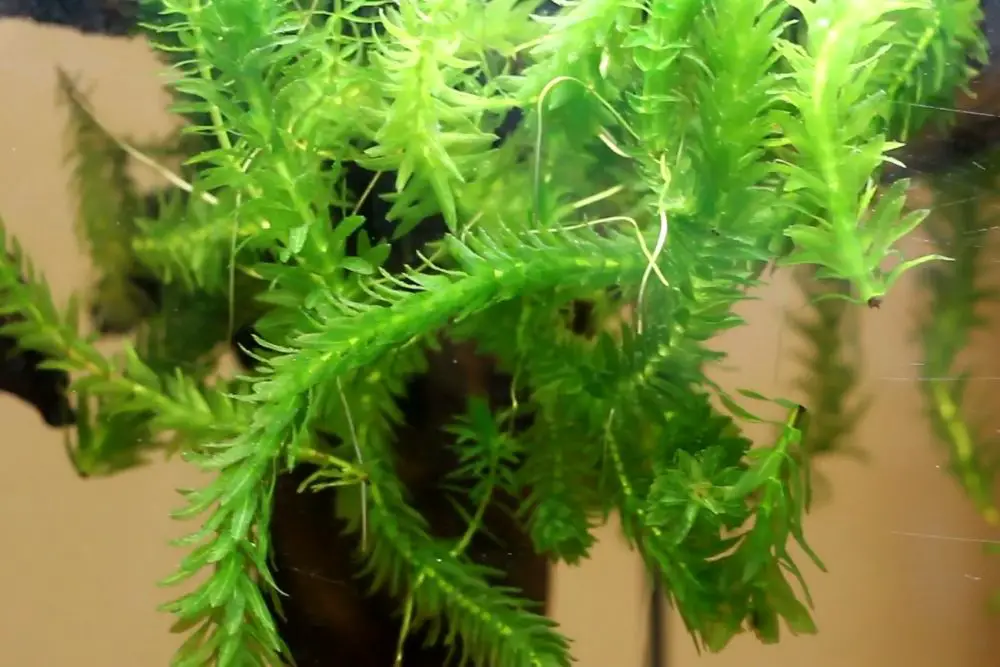
Once the aquarium is sufficiently aged (about six months), Elodea (formerly called Anacharis) adapts quite well to the temperatures of a guppies aquarium. Its highly branched stems can grow to over 3 feet (1m), even in a small aquarium, by growing around the tank in a tangle.
The plants are useful as a background, because they can be trimmed to the height of the aquarium (which is true of most of the non-rooted plants). Elodea is a dark green color.
Cabomba
Popularly known as fanwort because the leaf whorls look like lacy fans spread around the stems, Cabomba is a very delicate plant that easily falls apart, especially in the presence of guppies, which are likely to nibble at it.
Myriophyllum
Of all the bushy non-rooted plants. Myriophyllum, commonly known as water milfoil, is by far the hardiest. It can tolerate almost any aquarium conditions, as long as there is nutrient material in the water. Because of its extreme bushiness, long winding and branching stems, and its dark green color, it is an excellent background plant.
Hygrophila Polysperma
This is one of the most frequently seen cut, bunched plants. Its light-green leaves grow out of stem nodules in pairs, usually 180 degrees apart. Alternating leaf pairs grow perpendicular to one another, so looking down from the top of a stalk the leaves seem to come out in four directions 90 degrees apart.
The plant does not branch much, although branching can be promoted by pruning. The plant can tolerate most aquarium water and takes cool temperatures quite well.
When cuttings are planted in a moderately rich medium, they grow dense thickets of white roots It is assumed, therefore, that this plant takes some of its nourishment from the substrate as well as some directly from the water.
The plant is recommended as background if it is allowed to grow to the surface, and as foreground if it is trimmed short. Its only drawback is that it requires very strong tight. In weak light, it loses leaves.
Water wisteria, another easily grown, readily available species, fares better in medium light than Hygrophila Polysperma.
Ludwigia
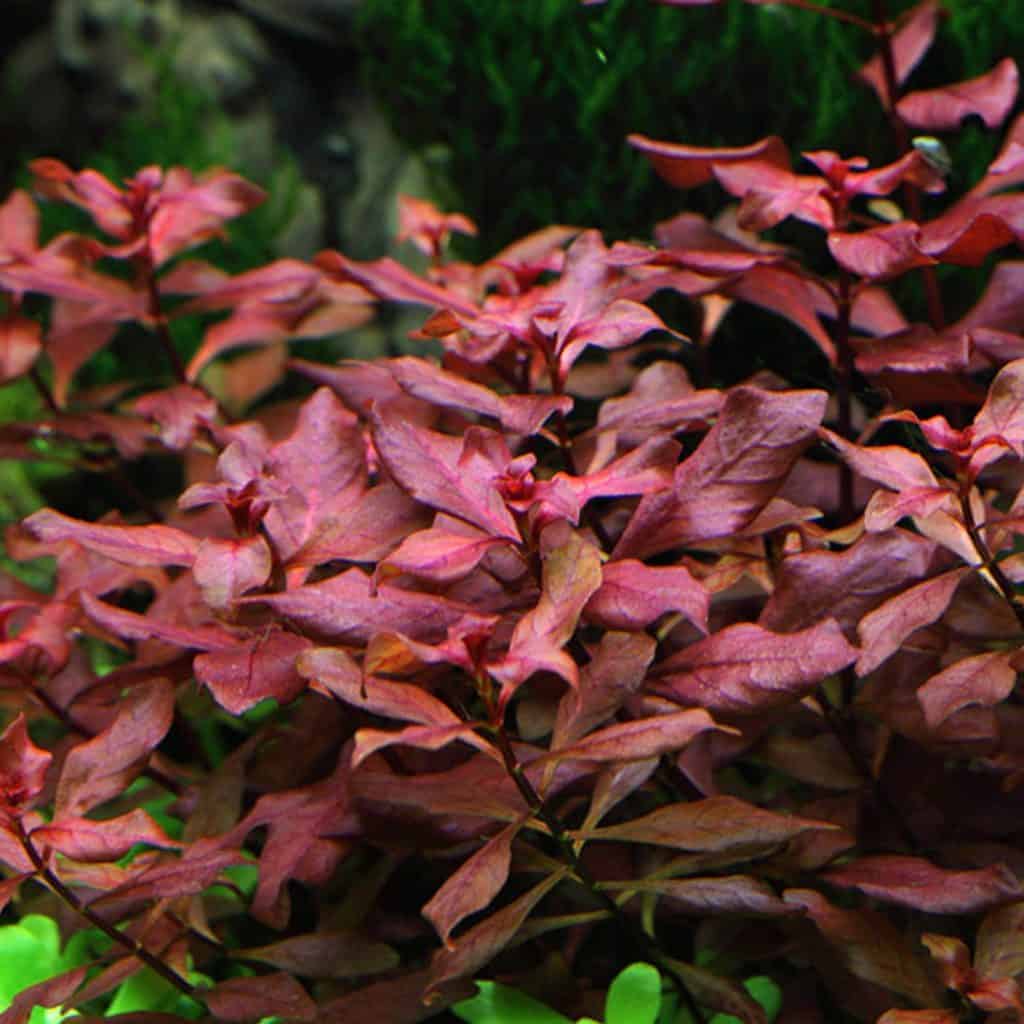
Frequently seen in aquarium stores. Ludwigia is very similar in all respects to Hygrophila, except that its leaves tend to take on a reddish color, especially on the underside. It should be handled the same way as Hygrophila, but it is even less tolerant of weak light.
Summary
The list in this post is far from complete, and once your guppies aquarium is well established, there are many other varieties of plants that can be used. No matter what plants you choose for your aquarium, in the end it all comes down to understanding what you are doing and being patient.
An aquarium full of flourishing plants cannot be established in a few weeks. It may take a year or more for the plant life in your aquarium to develop as you want it. The reward, however, is worth the wait, for if good maintenance practices are followed, it is not inconceivable that a well-planted aquarium can go on almost indefinitely without being broken down for a complete cleaning.

Hi, my name is Sean, and I’m the primary writer on the site. I’m blogging mostly about freshwater and saltwater aquariums, fish, invertebrates, and plants. I’m experienced in the fishkeeping hobby for many years. Over the years I have kept many tanks, and have recently begun getting more serious in wanting to become a professional aquarist. All my knowledge comes from experience and reading forums and a lot of informative sites. In pursuit of becoming a professional, I also want to inspire as many people as I can to pick up this hobby and keep the public interest growing.
Read more about Sean.
Please join also my Facebook group.

